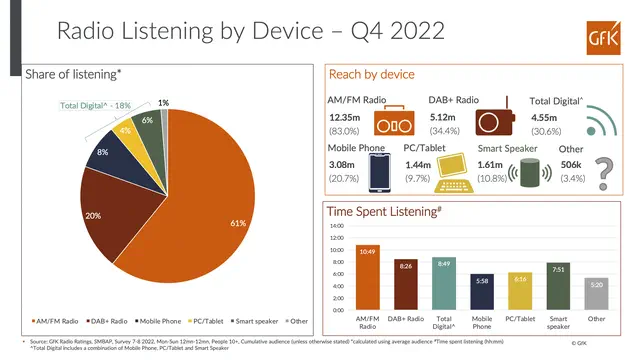How do Australians listen to the radio?

After a refreshed website from CRA, this incredibly helpful data from GfK became no longer available; so here it is, rescued out of the archives, to help us understand how radio is listened-to in the capital cities in Australia.
At the end of 2022, radio looked like this…
Share of all radio listening
- 61% of total radio listening was to AM/FM radio.
- 20% of total radio listening was to a DAB+ receiver.
- 18% of total radio listening was to online/streaming (marked as “digital” in the above graph).
Alternatively: in Australia, almost 40% of all radio listening does not happen on an AM/FM radio.
Total people listening
- 83% of people use an AM/FM radio each week
- 34.4% of people use a DAB+ receiver each week
- 30.6% of people use radio via online/streaming each week (marked as “digital” in the above graph).
Alternatively: in Australia, over a third of people use a DAB+ receiver every week to listen to the radio.
Time spent on each device
Finally, you’ll see the “time spent listening” graph, which is presumably “time per listener” (since if you don’t use a platform, you’re going to listen to zero). For the benefit of search engines:
- People who use AM/FM spend 10 hours 49 minutes a week listening to radio through it
- People who use DAB+ receivers spend 8 hours 26 minutes a week listening to radio through them
- People who use radio via online/streaming spend 8 hours 49 minutes a week listening to radio through it
- …although, people spend half as long using their mobile phones for live radio than they do for AM/FM.
“People” in the above are Australians aged 10+. This data is ONLY for Sydney, Melbourne, Brisbane, Adelaide and Perth. (DAB+ radio transmissions are also available in Hobart, Darwin, Gold Coast and Canberra).
Further questions you may have
Where’s the latest data?
From Q1 2023, the methodology of how radio figures are calculated was changed in Australia. As part of that change, it’s my understanding that “listening by device” figures are not produced. So these are the latest we have.
What’s a DAB+ receiver?
It’s a radio, like an AM/FM one, with an antenna and a speaker. It offers more choice than AM/FM, and you tune in using the station name, not by a frequency. Here’s a search of the JB Hi-Fi website so you can see what they look like. DAB+ doesn’t use the internet - it’s just a different type of radio. In addition, DAB+ radio receivers are in most cars, alongside FM.
How many cars have DAB+ radio receivers in them in Australia?
By 2020, 75% of new cars were sold with DAB+ radios. The average age of cars on the road in Australia is 11.1 years; given that, it’s now likely that the majority of cars today have DAB+ receivers in them.
If I listen to 2DAY FM 104.1 on DAB+, how is that counted in the figures?
In the graph above, this listening appears under DAB+. But all listening to 2DAY FM - on DAB+, or online - appears in the main radio listening figures for the station. 2DAY can privately break out the figures in terms of platform listened, but they’re not published.
Do these figures include podcasts?
No. (With one caveat: it’s possible that someone may listen to a Triple M podcast, say, and tick “Triple M” in the diary - but that’s unlikely to be widespread).
Why are the “total people” figures so different to the “total share of listening”?
Typically, people use more than one device to listen to the radio, hence why these numbers are different. Perhaps someone listens to radio at home on an FM receiver; but listens in the car on a DAB receiver.
How does AM/FM split in Australia?
That isn’t published. For stations like 2GB, 4BH or ABC Radio Melbourne, only those stations know how music of their listening is to AM, how much is to DAB+, and how much is online.
How does this compare to the UK?
RAJAR publishes these figures. But, use caution when looking at the figures because definitions used in the UK are different. Using the same definitions, for share of listening:
- 26.6% of total radio listening in the UK is to AM/FM radio (61% in Australia).
- 41.8% of total radio listening in the UK is to a DAB+ receiver (20% in Australia).
- 29.3% of total radio listening in the UK is to online/streaming (18% in Australia).
Does this really mean DAB+ is more popular than online streaming?
Yes: both sets of data currently show that DAB+ is used by more people, and has a bigger share of listening, than online/streaming.
Why?
DAB+ doesn’t need an internet connection. It’s in the majority of cars, and doesn’t need any phone plugging in or paired - it’s just there. And, for all the ubiquity of smart phones, radio listeners tune in for about half the time on mobile phones than they do on AM/FM, because their phones are used for all kinds of other things.